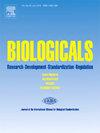Production and characterization of monoclonal antibodies against hepatitis B e-antigen and their potential application for development of HBeAg detection ELISA
IF 1.5
4区 生物学
Q4 BIOCHEMICAL RESEARCH METHODS
引用次数: 0
Abstract
Despite global vaccination efforts, hepatitis B virus (HBV) infection remains a major health threat, causing over a million deaths annually. Hepatitis B e-antigen (HBeAg) is an indicator of HBV replication and high infectivity. HBeAg is an essential serological marker for monitoring response to treatment and/or determining the stage of chronic HBV infection. Here, we produced a panel of mouse hybridomas secreting monoclonal antibodies (MAbs) to HBeAg by fusing a mouse myeloma cell line with splenocytes from mice immunized with recombinant HBeAg. Anti-HBe MAbs were then characterized by competition ELISA and Western blotting. We designed and optimized an in-house sandwich ELISA using HBeAg-specific rabbit polyclonal and mouse monoclonal antibodies. The diagnostic performance of the assay was then compared to a commercial HBeAg detection ELISA kit using 176 HBeAg[-] and 44 HBeAg[+] serum samples, showing a significant positive correlation (r = 0.8250; P < 0.0001). The in-house ELISA showed reasonable sensitivity (97.56 %) and specificity (99.40 %), with a cut-off value and area under the curve of 0.193 and 0.9884, respectively. Additionally, the assay showed high repeatability, with intra- and inter-assay coefficients of variation of 2.46 % and 11.38 %, respectively. Our designed HBeAg-detecting sandwich ELISA has the potential for use in clinical diagnosis.
乙型肝炎e抗原单克隆抗体的制备、鉴定及其在HBeAg检测ELISA中的潜在应用
尽管全球努力进行疫苗接种,但乙型肝炎病毒(HBV)感染仍然是一个主要的健康威胁,每年造成100多万人死亡。乙型肝炎e抗原(HBeAg)是乙型肝炎病毒复制和高传染性的指标。HBeAg是监测治疗反应和/或确定慢性HBV感染分期的重要血清学标志物。在这里,我们通过将小鼠骨髓瘤细胞系与重组HBeAg免疫小鼠的脾细胞融合,产生了一组分泌HBeAg单克隆抗体(mab)的小鼠杂交瘤。然后用竞争ELISA和Western blotting检测抗- hbe单克隆抗体。我们利用hbeag特异性兔多克隆抗体和小鼠单克隆抗体设计并优化了夹心ELISA。使用176份HBeAg[-]和44份HBeAg[+]血清样本,将该方法的诊断性能与商用HBeAg检测ELISA试剂盒进行比较,显示出显著的正相关(r = 0.8250;P
本文章由计算机程序翻译,如有差异,请以英文原文为准。
求助全文
约1分钟内获得全文
求助全文
来源期刊

Biologicals
生物-生化研究方法
CiteScore
3.70
自引率
0.00%
发文量
39
审稿时长
48 days
期刊介绍:
Biologicals provides a modern and multidisciplinary international forum for news, debate, and original research on all aspects of biologicals used in human and veterinary medicine. The journal publishes original papers, reviews, and letters relevant to the development, production, quality control, and standardization of biological derived from both novel and established biotechnologies. Special issues are produced to reflect topics of particular international interest and concern.Three types of papers are welcome: original research reports, short papers, and review articles. The journal will also publish comments and letters to the editor, book reviews, meeting reports and information on regulatory issues.
 求助内容:
求助内容: 应助结果提醒方式:
应助结果提醒方式:


